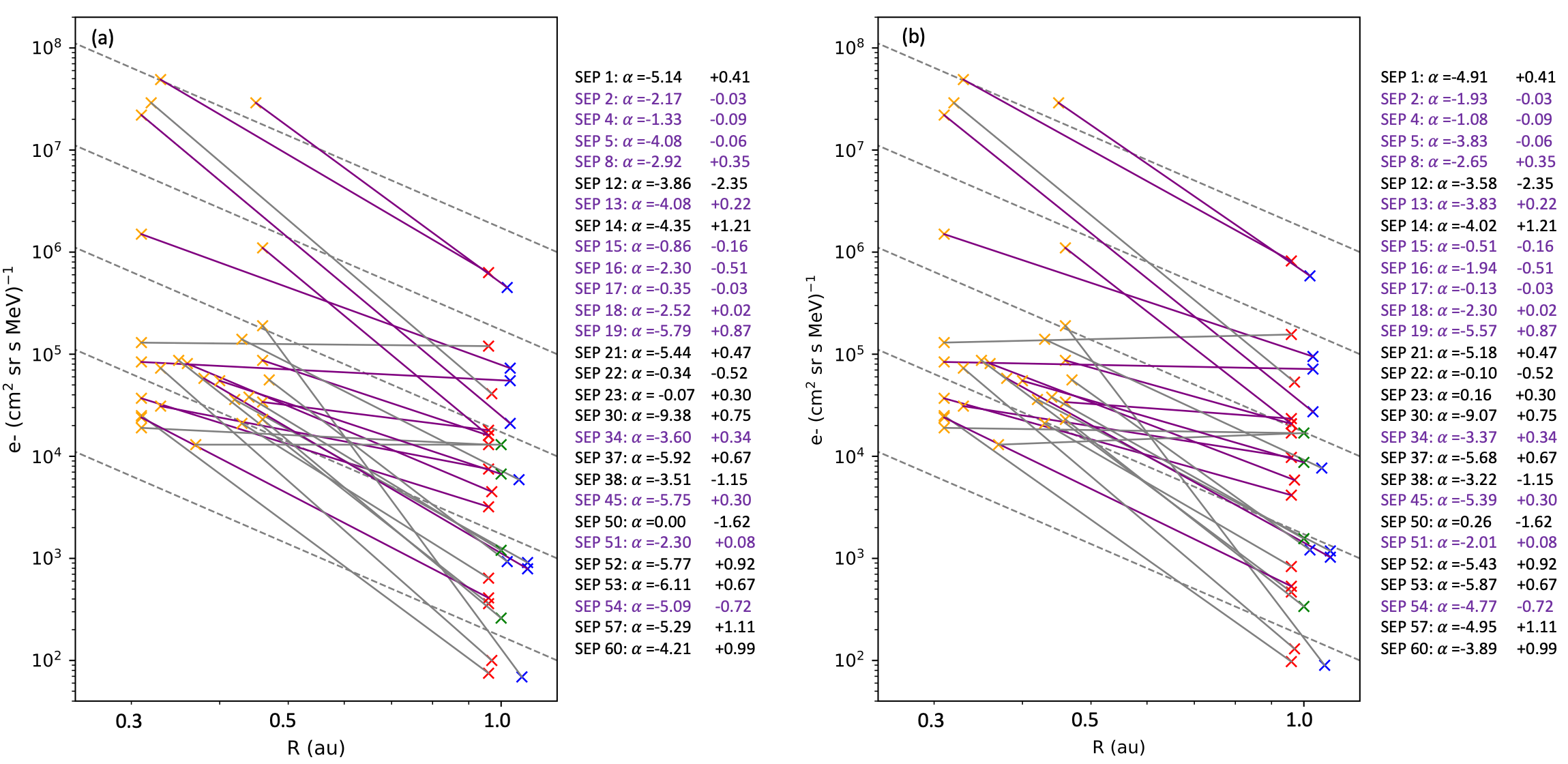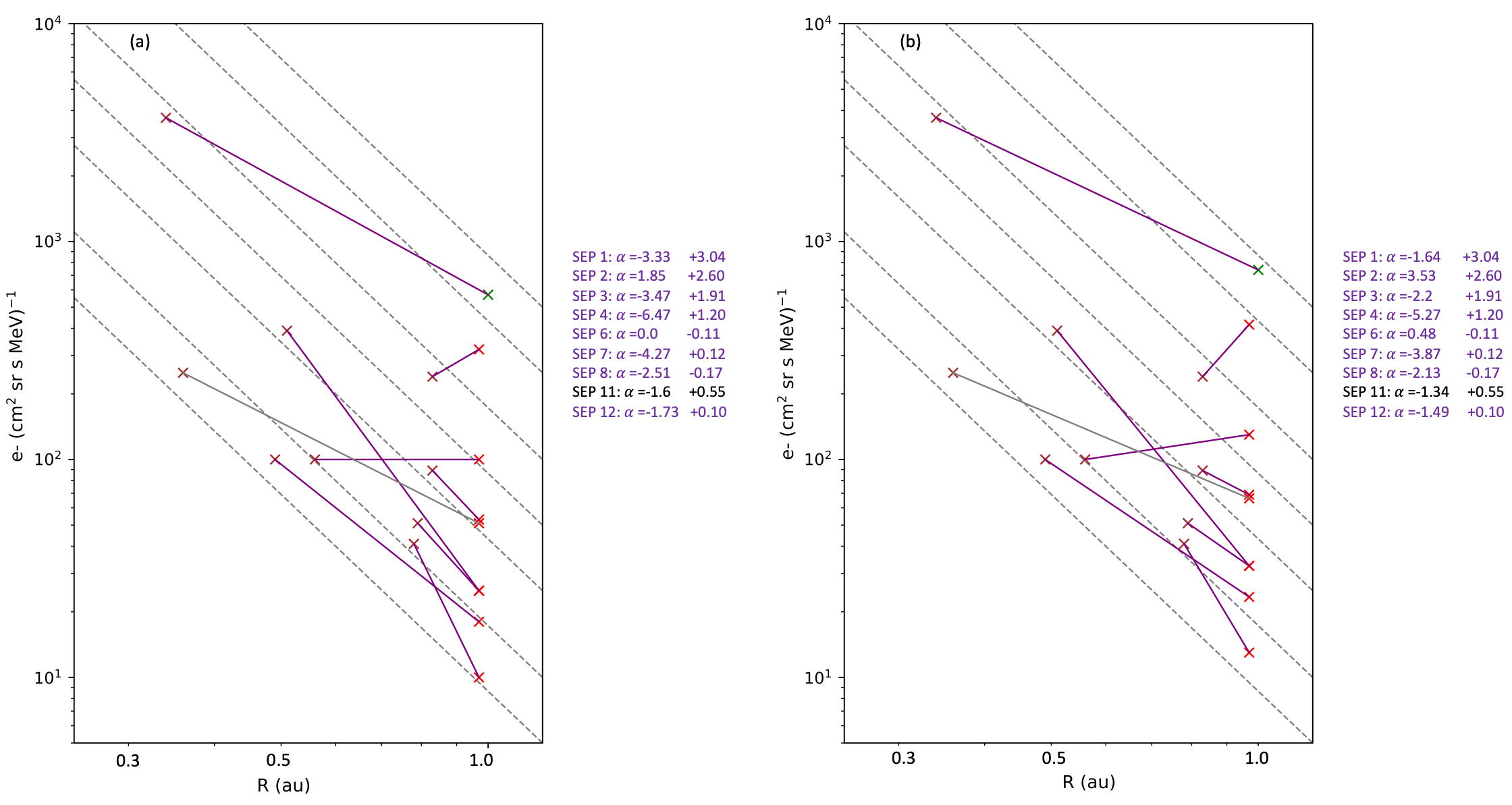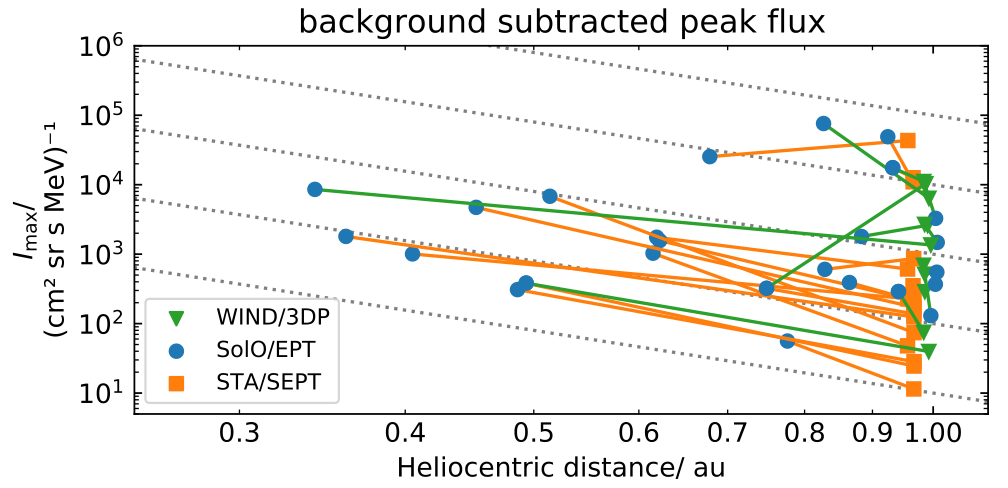Science nugget: Radial dependence of the peak intensity of solar energetic electron events in the inner heliosphere - Solar Orbiter
Radial dependence of the peak intensity of solar energetic electron events in the inner heliosphere
(Solar Orbiter nugget #2 by Laura Rodríguez-García1, Alexander Kollhoff2, and the Solar Orbiter/EPD team)
Introduction
Observing solar energetic electron (SEE) events with multiple spacecraft at different heliocentric distances is crucial to determine the transport effects of solar particle events. However, the radial dependence of SEE peak intensities is difficult to study due to the simultaneous occurrence of radial and longitudinal effects, which cannot be easily disentangled in data analysis([1],[2]). In principle, the intensities of particles observed by two spacecraft at different radial distances but magnetically connected to the same solar source region depend on how particles are injected onto the interplanetary magnetic field line that connects the two spacecraft. They also depend on how energetic particles are transported from the source region towards the observers[3]. However, the magnetic connection between two spacecraft cannot always be guaranteed, and the radial dependence of SEE intensities may vary between individual events. Therefore, statistical analysis over a large number of events is necessary to characterize the SEE properties, such as the radial dependence of the SEE peak intensities.
The studies by Rodríguez-García et al.[4] and Kollhoff et al.[5] presented below use three different data sets to independently determine the radial evolution of near-relativistic electron peak intensities. In all cases, the solar energetic electron (SEE) events were measured by two radially-separated spacecraft that were closely magnetically aligned. The use of these data sets is significant because measurements of the radial dependence of electron events are rare, mainly due to the scarcity of SEE event measurements at heliocentric distances less than 1 au.
Multi mission measurements of SEE events
Rodríguez-García et al.[4] used 28 SEE events measured from February 2010 to April 2015 at different heliocentric distances obtained by EPS*, which is part of the EPPS* instrument[6] on board the MESSENGER* mission[7] near 0.4 au; by SEPT*[8] on board the twin STEREO* spacecraft[9]; and by EPAM*[10] on board the ACE* spacecraft[11] near 1 au. To estimate the magnetic connections, the study assumed a Parker spiral field configuration with a solar wind speed of 400 km s-1 because MESSENGER lacks solar wind measurements. The study is limited to events with an estimated longitudinal separation of the nominal footpoints between MESSENGER and near 1 au spacecraft of ≤ 35° in order to separate the longitudinal and radial effects. To increase statistics, one-hour averages of the 71-112 keV channel were used to determine the peak intensities of the SEE events.
Rodríguez-García et al.[4] utilized a second data set comprising 9 SEE events measured in February and March 2022 by the EPT* instrument, which is a part of EPD*[12] on board Solar Orbiter[13] when the spacecraft's radial distance to the Sun ranged from 0.34 to 0.83 au. To ensure consistency with the MESSENGER analysis, one-hour averaging was utilized in the 73-111 keV electron energy range. In both studies, the authors considered small longitudinal effects (i.e., not exactly the same nominal connection angle between the two radially-aligned spacecraft) and the intercalibration factor between the instruments.
Kollhoff et al.[5] used Solar Orbiter/EPD/EPT data from September 2021 to March 2022 including 25 SEE events, when Solar Orbiter was 0.34 to 1.0 au from the Sun. For near-Earth measurements, 3DP instrument on board Wind[14] was used. In this study, only events with small longitudinal separation (<15°) between their nominal magnetic foot-points were selected. For the approximation of the foot-point separation, a ballistic back-mapping approach using in situ solar wind speed measurements was followed. 15-minute-averaged intensities of the ≈50−86 keV electron were used.
Figure 1 displays the distribution of near-relativistic electron peak intensities as a function of heliocentric distance in the 28 SEE measured by MESSENGER/EPS and near 1 au spacecraft, such as STEREO-A and B, and ACE, when in close nominal connection by a Parker spiral. The indices α, assuming a radial dependence Rα for the maximum intensities, are listed on the right of each plot. The dashed black lines indicate an upper limit of R-3 radial dependence, obtained through the observational and modelling studies outlined in detail in section 3 of [3].

Figure 1. Radial dependence of the quasi-relativistic electron intensities in SEE events measured by MESSENGER. (a) The lines connect the SEE events for which the longitudinal separation of the nominal footpoints of MESSENGER and the respective observation point near 1 au were ≤ 35°. The orange, red, blue, and green crosses indicate the peak intensities observed by MESSENGER, STEREO-A, STEREO-B, and ACE, respectively. The dashed lines indicate a R-3 radial dependence. The legend on the right indicates the α index if a radial dependence ∝ Rα is assumed for each of the SEE events listed. The numbers next to each α index are corrections based on the small longitudinal effect. Purple indicates the subset of events where the separation of the nominal footpoints of MESSENGER and the respective spacecraft near 1 au were < 20°. (b) Same as panel (a), but including an interspacecraft calibration factor of 1.3 on the STEREO measurements (details given in [4]).
Figure 2 displays a similar radial dependence as Figure 1 but for the 9 SEE events measured by Solar Orbiter/EPD/EPT near the first nominal perihelion in March 2022.

Figure 2. Radial dependence of the near-relativistic electron intensities in SEE events measured by Solar Orbiter. (b) Same as panel (a), but including an interspacecraft calibration factor of 1.3 on the STEREO measurements (details given in Figure 3 and by [4]).
Figure 3 presents the results for the 25 SEE events measured by Solar Orbiter/EPD/EPT from September 2021 to March 2022.

Figure 3. Radial dependency of the SEE peak intensity. Observations made by Solar Orbiter/EPT, Wind/3DP, and STEREO-A/SEPT are shown as blue circles, green triangles, and orange squares, respectively. The solid lines connect observations of the same event.The dotted lines in the top panel show an I ∝ R−3 dependence (details given by [5]).
Conclusions
Although there is a wide variability in the radial dependence of solar electron peak intensities, on average and within uncertainties, the radial dependence can be expressed as Rα, where <α> = -3. This radial dependence of electron peak intensity may be used in (and explained by) different particle modelling efforts. Further investigation of the analysis and outcomes presented here could be carried out with future multi-spacecraft observations as we progress into solar cycle 25. This could enable measurement of more intense events and increase statistics, which would allow for a reduction of uncertainties. We could also analyze events departing from the inferred radial dependence of peak intensities. Additionally, future cross-calibration studies during close approaches of different spacecraft will provide a more accurate intercomparison of datasets from different instruments.
More details can be found in the study by Rodríguez-García et al[4].
*Acronyms of instruments and missions:
ACE = Advanced Composition Explorer
EPAM = Electron, Proton, and Alpha-particle Monitor
EPD = Energetic Particle Dector
EPPS = Energetic Particle and Plasma Spectrometer
EPS = Electron Proton Spectrometer
EPT = Electron Proton Telescope
MESSENGER = Mercury Surface, Space Environment, Geochemistry and Ranging
SEPT = Solar Electron and Proton Telescope
STEREO = Solar Terrestrial Relations Observatory
Affiliations:
1Universidad de Alcalá (UAH), Space Research Group, Alcalá de Henares, Madrid, Spain
2Institute of Experimental and Applied Physics, Kiel University, Kiel, Germany
Acknowledgments:
The UAH team acknowledges the financial support from the Spanish Ministerio de Ciencia, Innovación y Universidades FEDER/MCIU/AEI Projects ESP2017-88436-R and PID2019-104863RB-I00/AEI/10.13039/501100011033 and by the European Union’s Horizon 2020 research and innovation program under grant agreement No. 101004159 (SERPENTINE).
References:
[2] Lario, D., Kallenrode, M. B., Decker, R. B., et al. 2006, ApJ, 653, 1531
[3] Lario, D., Aran, A., Gómez-Herrero, R., et al. 2013, Astrophysical Journal, 767, 41
[4] Rodríguez-García, L., Gómez-Herrero, R., Dresing, N., et al. 2023, A&A, 670, A51
[5] Kollhoff et al., 2023, A&A, 675, A155
[6] Andrews, G. B., Zurbuchen, T. H., Mauk, B. H., et al. 2007, Space Sci. Rev.,131, 523
[7] Solomon, S. C., McNutt, R. L., Gold, R. E., & Domingue, D. L. 2007, Space Sci. Rev., 131, 3
[8] Müller-Mellin, R., Böttcher, S., Falenski, J., et al. 2008, Space Sci. Rev., 136, 363
[9] Kaiser, M. L., Kucera, T. A., Davila, J. M., et al. 2008, Space Sci. Rev., 136, 5
[10] Gold, R. E., Krimigis, S. M., Hawkins, S. E., I., et al. 1998, Space Sci. Rev., 86, 541
[11] Stone, E. C., Frandsen, A. M., Mewaldt, R. A., et al. 1998, Space Sci. Rev., 86, 1
[12] Rodríguez-Pacheco, J., Wimmer-Schweingruber, R. F., Mason, G. M., et al. 2020, A&A, 642, A7
[13] Müller, D., St. Cyr, O. C., Zouganelis, I., et al. 2020, A&A, 642, A1
[14] Szabo, A. 2015, Handbook of Cosmic Hazards and Planetary Defense, 141
- Removed a total of (1) style text-align:justify;
Nuggets archive
2025
09/04/2025: Bursty acceleration and 3D trajectories of electrons in a solar flare
02/04/2025: Picoflare jets in the coronal holes and their link to the solar wind
19/03/2025: Radial dependence of solar energetic particle peak fluxes and fluences
12/03/2025: Analysis of solar eruptions deflecting in the low corona
05/03/2025: Propagation of particles inside a magnetic cloud: Solar Orbiter insights
19/02/2025: Rotation motions and signatures of the Alfvén waves in a fan-spine topology
12/02/2025: 'Sun'day everyday: 2 years of Solar Orbiter science nuggets that shed light on some of our star's mysteries
22/01/2025: Velocity field in the solar granulation from two-vantage points
15/01/2025: First joint X-ray solar microflare observations with NuSTAR and Solar Orbiter/STIX
2024
18/12/2024: Shocks in tandem : Solar Orbiter observes a fully formed forward-reverse shock pair in the inner heliosphere
11/12/2024: High-energy insights from an escaping coronal mass ejection
04/12/2024: Investigation of Venus plasma tail using the Solar Orbiter, Parker Solar Probe and Bepi Colombo flybys
27/11/2024: Testing the Flux Expansion Factor – Solar Wind Speed Relation with Solar Orbiter data
20/11/2024:The role of small scale EUV brightenings in the quiet Sun coronal heating
13/11/2024: Improved Insights from the Suprathermal Ion Spectrograph on Solar Orbiter
30/10/2024: Temporally resolved Type III solar radio bursts in the frequency range 3-13 MHz
23/10/2024: Resolving proton and alpha beams for improved understanding of plasma kinetics: SWA-PAS observations
25/09/2024: All microflares that accelerate electrons to high-energies are rooted in sunspots
25/09/2024: Connecting Solar Orbiter and L1 measurements of mesoscale solar wind structures to their coronal source using the Adapt-WSA model
18/09/2024: Modelling the global structure of a coronal mass ejection observed by Solar Orbiter and Parker Solar Probe
28/08/2024: Coordinated observations with the Swedish 1m Solar Telescope and Solar Orbiter
21/08/2024: Multi-source connectivity drives heliospheric solar wind variability
14/08/2024: Composition Mosaics from March 2022
19/06/2024: Coordinated Coronal and Heliospheric Observations During the 2024 Total Solar Eclipse
22/05/2024: Real time space weather prediction with Solar Orbiter
15/05/2024: Hard X ray and microwave pulsations: a signature of the flare energy release process
01/02/2024: Relativistic electrons accelerated by an interplanetary shock wave
11/01/2024: Modelling Two Consecutive Energetic Storm Particle Events observed by Solar Orbiter
2023
14/12/2023: Understanding STIX hard X-ray source motions using field extrapolations
16/11/2023: EUI data reveal a "steady" mode of coronal heating
09/11/2023: A new solution to the ambiguity problem
02/11/2023: Solar Orbiter and Parker Solar Probe jointly take a step forward in understanding coronal heating
25/10/2023: Observations of mini coronal dimmings caused by small-scale eruptions in the quiet Sun
18/10/2023: Fleeting small-scale surface magnetic fields build the quiet-Sun corona
27/09/2023: Solar Orbiter reveals non-field-aligned solar wind proton beams and its role in wave growth activities
20/09/2023: Polarisation of decayless kink oscillations of solar coronal loops
23/08/2023: A sharp EUI and SPICE look into the EUV variability and fine-scale structure associated with coronal rain
02/08/2023: Solar Flare Hard Xrays from the anchor points of an eruptive filament
28/06/2023: 3He-rich solar energetic particle events observed close to the Sun on Solar Orbiter
14/06/2023: Observational Evidence of S-web Source of Slow Solar Wind
31/05/2023: An interesting interplanetary shock
24/05/2023: High-resolution imaging of coronal mass ejections from SoloHI
17/05/2023: Direct assessment of far-side helioseismology using SO/PHI magnetograms
10/05/2023: Measuring the nascent solar wind outflow velocities via the doppler dimming technique
26/04/2023: Imaging and spectroscopic observations of EUV brightenings using SPICE and EUI on board Solar Orbiter
19/04/2023: Hot X-ray onset observations in solar flares with Solar Orbiter/STIX
12/04/2023: Multi-scale structure and composition of ICME prominence material from the Solar Wind Analyser suite
22/03/2023: Langmuir waves associated with magnetic holes in the solar wind
15/03/2023: Radial dependence of the peak intensity of solar energetic electron events in the inner heliosphere
08/03/2023: New insights about EUV brightenings in the quiet sun corona from the Extreme Ultraviolet Imager








































 Sign in
Sign in
 Science & Technology
Science & Technology